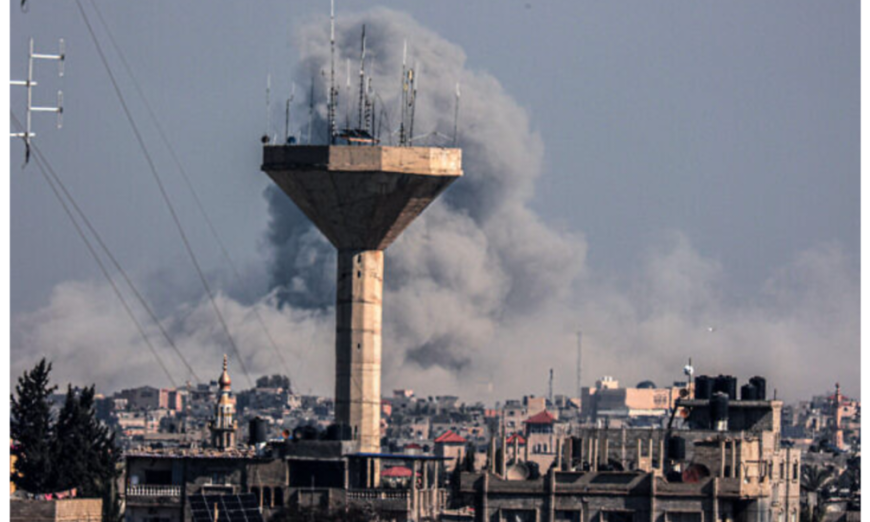A picture taken from Rafah in the southern Gaza Strip shows smoke rising over buildings in Khan Younis following Israeli bombardment on February 5, 2024, as fighting continues between Israel and the Hamas terror group.
Israel’s leaders claimed Monday that the IDF had killed or seriously injured half of the Hamas terror group’s fighters, and said the end of a nearly 4-month-old offensive in Gaza was a matter of months, not years, as fighting was set to spread to the southern metropolis representing the Strip’s final redoubt.
Prime Minister Benjamin Netanyahu vowed that Israel would achieve “complete victory,” even as military officials detailed resurgent fighting in areas of northern Gaza previously cleared by troops. The complicated situation underlines the difficulty Israel faces in meeting its war goals, though it looks to complete an unprecedented sweep by pushing into the southern city of Rafah.
And with Hamas’s top leaders still at liberty, Defense Minister Yoav Gallant insisted that the terror group’s Gaza leader Yahya Sinwar was on the run, out of touch with his fighters, and forced to flee from one hideout to another with the IDF hot on his heels.
“Our goal is a complete victory over Hamas,” Netanyahu told a meeting of his Likud party faction at the Knesset. “We will kill the Hamas leadership, so we must continue to operate in all areas in the Gaza Strip. We must not end the war before then. It will take time — months, not years.”
The estimate appeared to be more optimistic than a prediction Netanyahu reportedly gave local council leaders last month that the war would continue into 2025.
Visiting soldiers at Latrun in the center of the country, Netanyahu said that 18 out of 24 Hamas battalions had been destroyed, and that “there is no substitute for total victory.”
“We will not end the war without achieving that goal of total victory that will restore security,” he said. “We will not give it up.”
He did not lay out what total victory means, even as he continued to maintain that position, during ongoing negotiations for a deal with Hamas to secure freedom for the approximately 136 hostages held by terror groups in the Gaza Strip.

israeli Prime Minister Benjamin Netanyahu (center) meets with IDF soldiers in Latrun on February 5, 2024. (Haim Zach/ GPO)
The prime minister also said that Israel is “collapsing and destroying” Hamas’s tunnel network, a vast complex of hundreds of kilometers of subterranean passages cavities it uses to house and deploy its forces.
At a press conference in Tel Aviv, Gallant said “about half of the Hamas terrorists have been killed or seriously wounded,” echoing Netanyahu.
Neither figure put a number on the Hamas casualties. Israel previously said it had killed over 10,000 Hamas operatives in Gaza.
Gallant described the ground operation as “complex and complicated,” while “progressing and achieving its goals,” with the IDF active “in most of the territory of the Gaza Strip.”
He said Hamas’s leadership, including Sinwar, is “on the run.”
“Sinwar goes from hideout to hideout, and is unable to communicate with his surroundings,” Gallant said. “Sinwar does not lead the campaign, does not command the forces; he is busy with his personal survival. He changed from Hamas leader into fugitive terrorist, and IDF forces continue to pursue him.”
Gallant revealed that IDF troops have recently found significant material in the places where Sinwar “had recently been” and the information gleaned revealed insights into Hamas plans.

Israeli Defense Minister Yoav Gallant makes comments to the media on February 5, 2024. (Screenshot/GPO.)
He asserted that disagreements between Hamas officials in the Strip and those abroad “indicate panic and distress” in the terror group.
Echoing Netanyahu, Gallant said “18 Hamas battalions are dismantled and no longer function as fighting military frameworks.”
As the IDF pushes through the Hamas tunnel network, denying them as a place of refuge for terrorists, “we are increasing the pressure on the terrorists and the leaders of the terrorist organizations,” he said, and issued a warning to remaining Hamas fighters in Rafah stronghold.
“Every terrorist hiding in Rafah should know that his end will be like those in Khan Younis and Gaza [City],” Gallant said referring to two areas conquered by the advancing Israeli military.
The defense minister repeated the assertion that the IDF’s military pressure on Hamas will advance the return of the hostages held by the terror group.
Israel has vowed to destroy Hamas after its devastating October 7 cross-border attack that killed 1,200 people in the south of the country, mostly civilians, during an invasion by thousands of terrorists from Gaza. The attackers also abducted 253 people of all ages who were taken as hostages in Gaza.
An IDF offensive, including a ground campaign in Gaza, is aimed at eliminating Hamas and removing it from power in Gaza. But another declared goal of the campaign is freeing the hostages, of which 132 abducted that day are believed to still be held, not all of them alive. Four others, including the remains of two soldiers, have been held since 2014.
Regarding the hostages, Netanyahu noted at the Likud faction meeting that 110 have been released so far, almost all during a negotiated November lull, and said the framework for any future deal will be based on a similar formula. That deal saw Israel release roughly three times as many Palestinian security prisoners held in Israel in exchange for each hostage.
“Hamas has demands that we will not agree to,” Netanyahu said. Efforts to negotiate freedom for more hostages “will not be realized at any cost,” he said.
According to Hebrew media reports, relatives of Israelis held hostage by Hamas in Gaza were turned away from the meeting, after trying to arrange access for several weeks.
US, Qatari, and Egyptian mediators are aiming to secure a similar but broader ceasefire agreement to free the remaining hostages and stop the fighting for at least several weeks. Hamas has made ending the war and a complete withdrawal of Israeli forces from Gaza a condition for any hostage deal.
Officials in the terror group have in the past said they are seeking the release of thousands of Palestinian security prisoners, something Netanyahu has vowed will not happen. However, the prime minister is facing public pressure to reach a deal that brings the hostages home with weekly demonstrations drawing thousands to make that demand.

A woman walks past posters depicting Yahya Sinwar (L), the head of Hamas in the Gaza Strip, and Abu Obeida (R), the masked spokesman of Hamas’s Qassam Brigades, plastered on a wall in the Burj al-Barajneh camp for Palestinian refugees in Beirut’s southern suburb on February 5, 2024.
The remarks from Netanyahu and Gallant came as intense fighting continued in Gaza where the ground operation has cost the lives of 225 IDF soldiers.
Brig. Gen. Itzik Cohen, commander of the IDF’s 162nd Division, said his forces are increasing their operations against remaining Hamas operatives and infrastructure in the northern Gaza Strip.
The IDF largely captured northern Gaza and dismantled Hamas’s fighting force in the area in the first months of the war, withdrawing its troops and shifting fighting to the southern part of the Strip. However, in recent weeks it has redeployed in the area to keep Hamas from restaking a hold.
The IDF has estimated there are several hundred Hamas operatives still in northern Gaza.
Over the past week, the 162nd Division returned to operate in the central and northern parts of Gaza City, as well as the Shati Camp, where the military previously battled Hamas, the IDF said in the statement.
The military said the troops are raiding selected areas in northern Gaza and clearing it of Hamas operatives and infrastructure in an “in-depth and thorough manner.”
So far, the 162nd Division has killed hundreds of Hamas operatives and nabbed dozens more, as well as seized weapons during the raids, it said.
The IDF also published a video of close-quarters combat engaged in by troops as they face gunmen in Gaza. It showed how a gunman approached a group of paratroopers from behind and threw a grenade at them, which exploded nearby. One of the soldiers turned and shot dead the attacker, who was also armed with a knife and a second bomb.
At least 27,365 people in Gaza have been killed, according to the Hamas-ruled territory’s health ministry. The figure cannot be independently verified and does not distinguish between civilians and combatants.
Gazans have faced dire humanitarian conditions, and the UN agency for Palestinian refugees, UNRWA, said on X that “there is very limited access to clean water and sanitation amid relentless bombardment.”
The intense fighting has displaced hundreds of thousands of Gazans, with tens of thousands seeking safety from the war by escaping out of Gaza and into bordering Egypt.
Over 35,000 people have left the Gaza Strip for Egypt through the Rafah crossing since November, according to a spokesman for the Egyptian Border Authority quoted by al-Araby al-Jadeed, amid reports Gazans were paying bribes to leave the Strip.
The figure reportedly includes an estimated 2,000 sick and wounded people who have entered Egypt for medical treatment, as well as staff of international institutions, Egyptian passport holders, and dual citizens.
The official added that under normal circumstances, about 15,000 people a month cross the Rafah border crossing, so over three months (November-January), the expected traffic should stand at 45,000.
The Qatari-owned news outlet quoted Ammar Fayed, an international relations researcher, claiming that the number of wounded people allowed to cross into Egypt for treatment is negligible and “symbolic,” as it amounts to only about 0.3% of those in need.
Egypt is said to have adopted measures to prevent the exploitation of Gazans trying to leave the Strip, after reports emerged that some of them were forced to pay as much as $10,000 to border officials to cross.
Al-Araby al-Jadeed reported that Cairo decided in mid-December to replace much of the staff manning the crossing and to appoint supervisors to monitor their work and prevent extortion.

